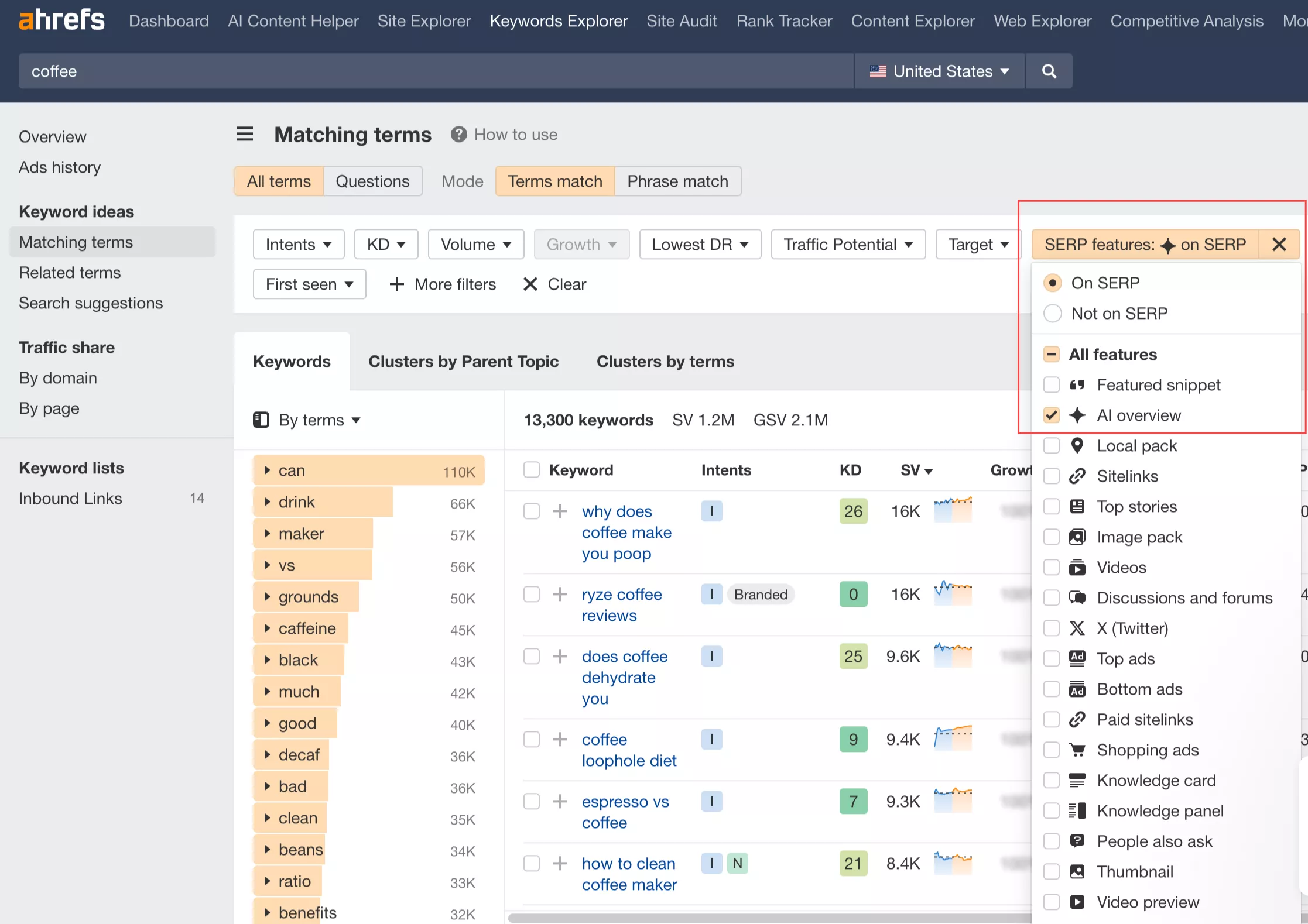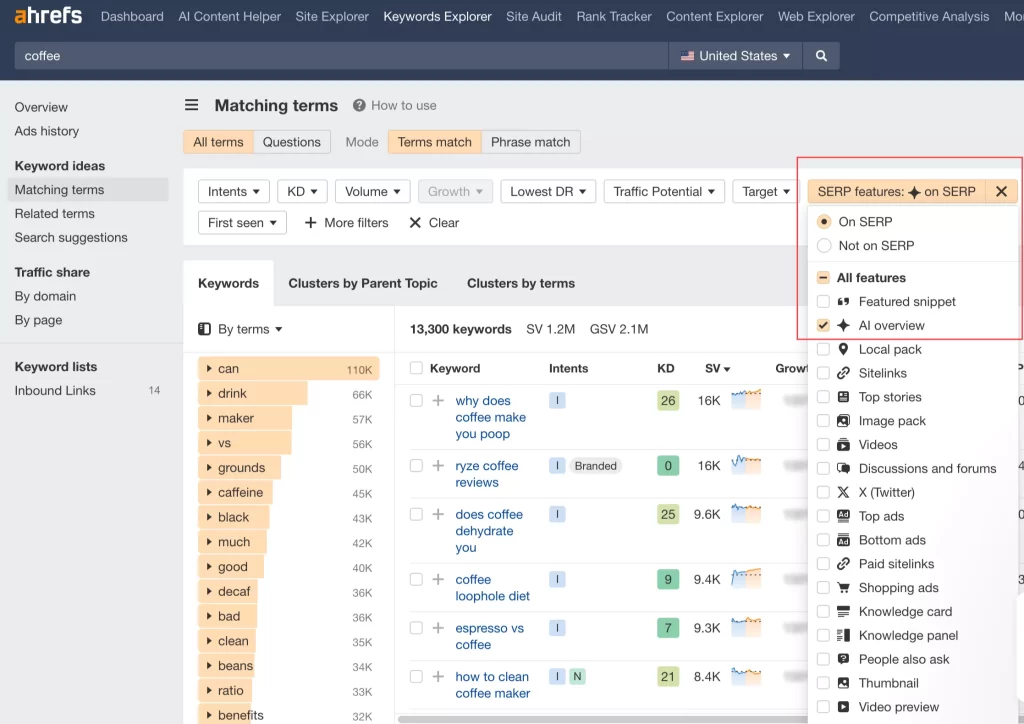Content Strategy and Link Building for Google AI Overviews
As search evolves, the rise of AI overviews in Google results brings fresh opportunities for visibility, but the fundamentals remain the same. While it’s not about optimizing content solely for AI, a strong SEO foundation enhances your brand’s presence across all search experiences, including AI-driven results.
The essentials of SEO—well-structured, unique, and genuinely helpful content—continue to be the bedrock of visibility. However, as digital marketers aiming to build authority and relevance, we can consider AI Overviews as an additional layer that increases brand exposure.
AI overviews offer the chance for brands to surface in a different light, adding an opportunity for expanded visibility in high-quality content spaces.
Content Strategy and Link Building for Google AI Overviews
Developing a solid link building and content strategy is pivotal to achieving the right positioning in AI overviews. The key to success is consistently updating content to match user intent, answering complex queries, and designing content that fulfills user needs.
1. Monitor SERP Features for Target Keywords
Monitoring SERP features helps you stay competitive. Some queries now feature AI-generated summaries, videos, images, and other multimedia elements. For example, Google may display a “People Also Ask” section, AI-generated overviews, and even knowledge panels for specific keywords.
Tools like Ahrefs, and SEMRush can identify which keywords yield SERP features, like AI overviews, that may benefit from multimedia content additions. This data enables you to adjust your content by incorporating structured data, images, or videos.
2. Creating High-Quality, User-Focused Content with EEAT
High-quality content, especially when structured for user engagement, enhances your visibility potential across search types. Google’s EEAT (Expertise, Experience, Authoritativeness, and Trustworthiness) are critical for ranking in AI-driven search.
Focus on creating original perspectives that add value (information gain), grounded in genuine expertise and real-life experience. Google’s AI algorithms identify rehashed content and can now better recognize authentic, informative resources.
Showcase your expertise by weaving in firsthand examples, studies, and insights that differentiate your content from competitors. Content that draws from expertise is more likely to rank and appear in AI-driven summaries.
3. Deep Dive into Audience Research and Core Topics
In-depth audience research is non-negotiable in aligning content with user intent and needs. Google’s ranking systems now prioritize content relevant to a website’s primary purpose. Publishing content that strays from core topics risks diminishing your authority in Google’s view.
Create audience personas to understand what your audience values. Develop content around these insights to ensure they resonate and fulfill their needs.
Ensure each piece of content addresses your audience’s pain points and challenges. If your site focuses on digital marketing, avoid publishing unrelated topics, as Google now distinguishes unrelated content sections within a site.
Google recently noted a shift in visibility for sections of sites like “Fortune Recommends” and “Forbes Advisor” due to disjointed content that wasn’t fully aligned with each site’s primary theme.
4. Link Building That Complements Core SEO
Backlinks remain crucial for reinforcing authority, yet placement has become more strategic in AI. Here’s how to build links that serve both organic search and AI-driven summaries:
- Be strategic in placing links on entities and sites you want to be topically associated with your brand.
- Consider sentiments in the context of the page's/content's overall message. Ensure they promote a more positive perception of your product/service and do not work against your offerings.
- Be on the lookout for links/resources/where-to-buy pages that can demonstrate your products' POV as they get included in the lists pages.
- Make quality control part of your process when checking the entire context of the page/content from which you aim to get links. Not only is it relevant to your site, but it must also help improve the association toward solving problems your prospective customers are experiencing.
5. Optimize Content for Complex Queries
With generative AI allowing users to ask intricate questions in one search, optimizing for query chains—consecutive follow-up questions—is more effective than targeting isolated keywords. By addressing connected topics, your content appears more thorough and relevant.
Write comprehensive guides that anticipate follow-up questions. For instance, if you write about “digital communication skills for HR,” also consider covering “how digital skills benefit talent development” or “common challenges HR faces in digital communication.”
By structuring content with linked topics, you increase the chances of AI identifying it as useful for multi-layered searches.
6. Publish Short-Form Videos Directly on Your Site with Structured Data
While platforms like TikTok, Instagram, and YouTube are popular for short-form video content, don’t overlook the value of hosting these videos on your website. Tools like Wistia can enhance video quality and user experience on your site.
By embedding videos directly, you keep traffic on your domain and have better control over the content’s SEO impact. Additionally, mark up your videos with structured data to make them more discoverable in Google Search and eligible for inclusion in AI overviews.
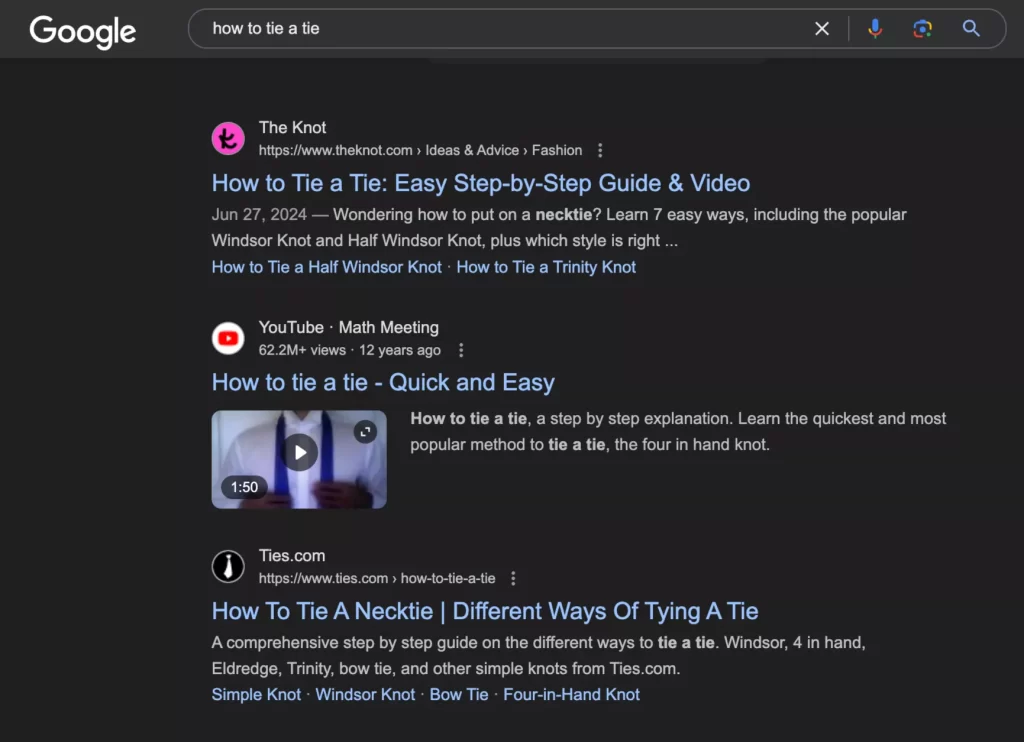
Embed product demos, explainer videos, or testimonials directly on relevant landing pages and use structured data to signal their relevance to Google. This can improve visibility in both standard search results and AI-driven summaries.
7. Enhance Sales Pages with FAQs and FUQs (Frequently Unanswered Questions)
Adding FAQs to your sales pages immediately answers common customer questions, enhancing user experience and optimizing for AI overviews. FUQs, or frequently unanswered questions, address nuanced or lesser-known queries, showcasing your in-depth expertise and understanding of the customer journey.
Identify customer pain points and unique questions that arise during the sales process. Incorporate FAQs and FUQs into your content strategy to address these needs proactively. This thoughtful design positions your content as a comprehensive, reliable source in current search results and evolving AI landscapes.
Positioning Content for Future Search Landscapes
Incorporating these practices prepares your content for success in an evolving SEO landscape, where AI-driven summaries may soon become more prominent. By blending traditional SEO with AI-conscious content practices, you build an adaptable content strategy that remains resilient in a changing environment.
The essentials—quality content, strategic link building, and user-focused design—create a content approach that thrives in AI and traditional search results, establishing your brand as a trusted source.
SEO-Driven Content Marketing For Startups
Create content that ranks and converts.
SEO-driven content marketing aims to rank pages and engage users so that they will convert.
While most SEOs vouch for just rankings, I do believe that content marketing activities should impact the business goals and objectives ─ and any marketing activity, for that matter.
In this guide, we’ll explore tips on utilizing content marketing for startups to drive SEO impact to your website.
1. Turn Audience Research to Content Clusters
Start by understanding the needs, interests, and challenges. This can involve creating a buyer persona that speaks to the demographic and psychographics of your target audience. Getting fresh data from your management team can also help pinpoint who your customers really are.
Create your ICP (Ideal Customer Profile), which describes your business' ideal customer based on common attributes like demographics, behavior patterns, needs, and pain points.
Then, use tools like Sparktoro or Ahrefs to discover topics and questions your ideal customers might be searching for to find solutions.
When looking for topics, ensure you tap into each stage of the marketing funnel (Awareness, Interest, Desire, and Action), or in the digital marketing realm, we have BOFU (bottom of the funnel), MOFU (middle of the funnel), and TOFU (top of the funnel).
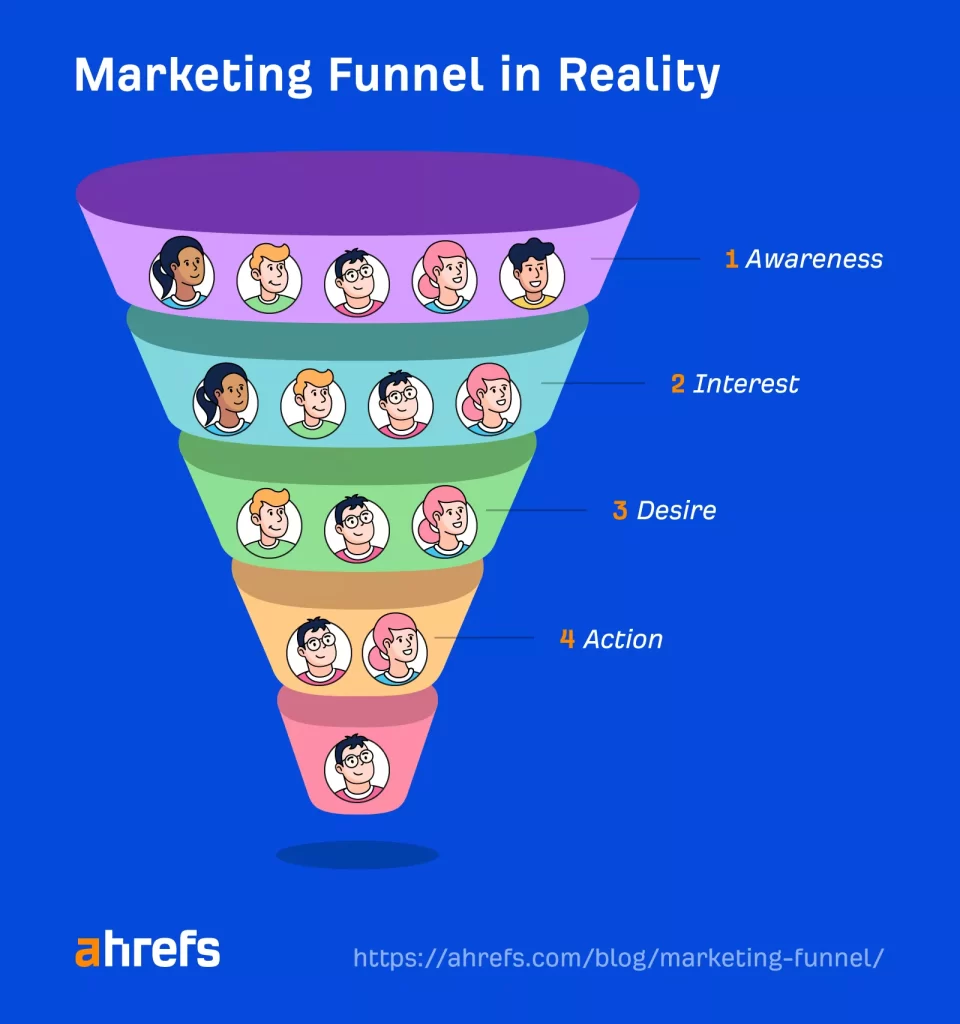
Even if it’s not a product/service page you’re publishing, you can still convert customers on your pages in the TOFU funnel (informational pages) as long as you deliver solutions to their needs and contextually place a solid call to action on your landing pages.
Here are a few steps to building effective topic clusters:
- Identify Core Topics: Identify 3-5 broad topics that align with your startup’s services, products, or expertise. These will become your pillar pages.
- Conduct Keyword Research: Use tools like Ahrefs, SEMrush, or Google’s Keyword Planner to find relevant keywords related to your core topics with significant search volume. Pro Tip: Do not skip zero-volume keywords that must be part of your content marketing base.
- Create Subtopics: Based on the keyword research, identify subtopics that address various facets of the core topic.
- Link Your Content: Interlink your pillar page with cluster pages. Internal linking helps search engines better understand your priority pages and improves the crawling and indexation of your new pages.
For instance, If your startup offers project management software, your pillar topic could be "Project Management Techniques". Cluster pages could cover subtopics like "Agile Methodology”, "Kanban vs. Scrum”, and "Project Management Tools for Startups”.
Publishing these product-led linkable assets can also lead to more link building opportunities while driving new users to your product or service.
2. Enlarge Your Publishing Base Through People-First Content
People-first content is about creating valuable, relevant, and high-utility content that meets the needs and expectations of your intended audience.
We’ll examine these four critical components of people-first content (Jason Acidre’s framework).
Needs Met
“Needs Met” is about how well your content matches the searcher’s intent and fulfills their expectations. Here’s how to ensure that your content meets this criterion:
- Intent Matching: Ensure your helpful content answers the exact queries your audience is searching for. Use tools like Search Console to identify common keywords and adjust your content to fulfill informational or commercial intent. Avoid misleading click-bait titles that don’t deliver on their promises.
- Target a Single Topic & Intent: Focus on a single topic, providing clear and concise answers without overwhelming the reader. Avoid burying essential information in long, multi-topic content. Consider using separate pages for subtopics with significant search volume.
- Direct Answers to Main Queries: Present direct answers prominently above the fold using formats like Quick Answer Boxes, Key Takeaways, or Summaries. This approach caters to users seeking quick information, especially on mobile devices.
- Remove Fluff Content: Keep your writing concise and relevant, eliminating off-topic, redundant, or overly wordy sections to maintain clarity and improve user experience.
For instance, in every blog post I write for our corporate training blog at Rainmakers, I determine the user intent of each search query. Asking the question, “What do they want to know first?” helped me prioritize points (and put them above the fold) so it would immediately satisfy the user's needs.
Here’s a recent post on “What is leadership to you?” The searchers would likely be students and learning and development practitioners who are looking for different schools of thought on the subject.
I delivered what they needed, based on my expertise on the subject:
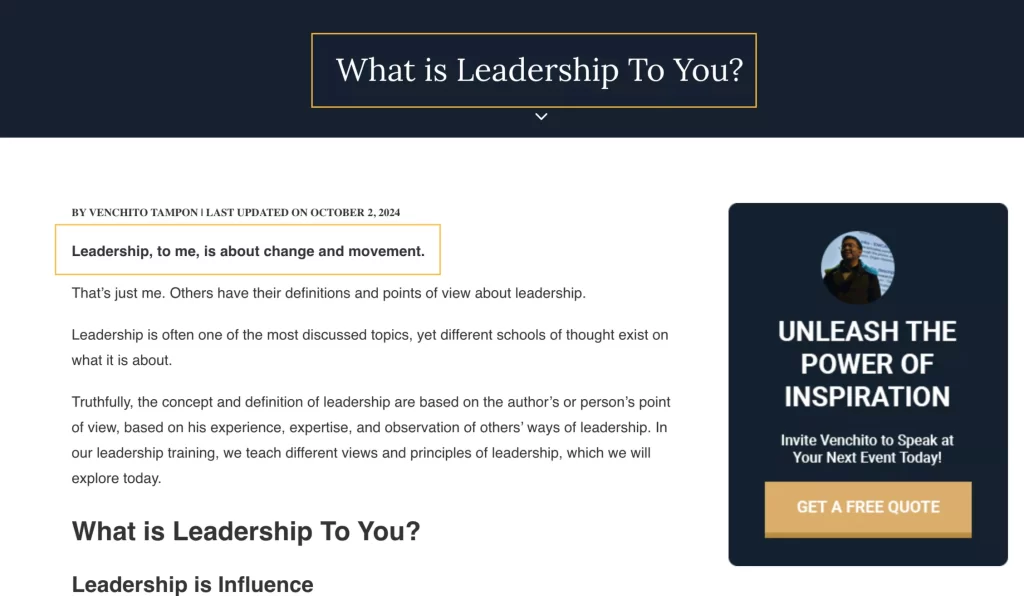
Another example is my coffee shop blog. We meet users’ needs by providing direct answers to certain questions (e.g., how much does it cost to start a coffee shop?).
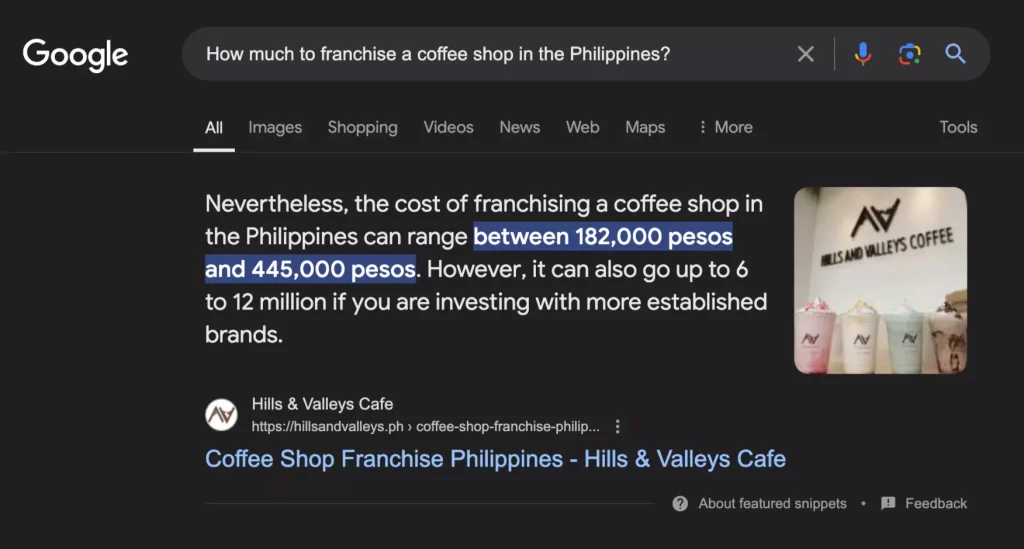
Now, this brings us to the next component of creating people-first content:
EEAT (Expertise, Experience, Authoritativeness, Trustworthiness)
By now, we should have known this populating all over SEO blogs. The ability to integrate EEAT into your content matters ─ here are few tips to leverage this:
- Comprehensive Author Details: Showcase the author's experience, expertise, education, achievements, and social media links to showcase their credibility (authorship SEO). A detailed bio builds trust and authority.
- Proper Sourcing & Citations: Cite reputable sources to demonstrate that your content is research-based and factual, enhancing trustworthiness and depth.
- Including Credible Stats or Expert Quotes: Incorporating statistics or expert quotes can boost content visibility and authority by 30-40%, providing evidence-based information that supports your claims.
- Accuracy of Information: Ensure your content is accurate, especially for industries like YMYL (Your Money, Your Life). Update facts and data regularly to maintain integrity and ethical standards.
- Editorial Process, Disclaimer, and/or Disclosure Statements: Include disclaimers, disclosures, or editorial policies to add transparency, authenticity, and clarity about the content’s intentions or potential biases.
Ahrefs has solidified its brand marketing by incorporating credible authors and experts to contribute insights and quotes to its blog posts, boosting the pages’ credibility and search performance.
Originality & Information Gain
Google emphasizes originality and information gain to combat the issue of copycat content. The goal is to provide unique insights that add value beyond existing content. Here’s how to enhance originality:
- First-Hand Knowledge: Share personal experiences, unique insights, or innovative ideas that address unmet needs. This will set your content apart and position your brand as an expert, potentially earning hard-to-replicate DR 90 backlinks.
- Original Research & Data: Conduct your research or gather data through surveys, experiments, or analysis. If you can't collect data, source it from public databases and present it from a unique angle to offer fresh insights.
- Provide Self-Sourced Images: Use original visuals like screenshots, branded infographics, product photos, or personal experience images to add authenticity and relatability. This makes your content more trustworthy and distinctive.
When incorporating experiences into your content, include what made you feel, see, touch, and taste ─ these are five senses only a person with actual experience on the topic can share in the content.
Give Depth To Your Content Assets
One of the WOSCON 2024 speakers, Kasra Dash, mentioned during the panel Q&A that building topical authority on a website requires publishing more pages within a relevant subject and achieving depth through topics that haven’t been published elsewhere.
Identify subtopics that could be expounded into single blog posts. Based on your expertise and experience, think of topics you can add more depth by giving more information on the “how-to” or new insights from real-world practice.
You can also publish internal data studies that align with topics to validate and support points. This is also an additional content asset that attracts new links to your page.
3. Build a Link-Earning Flywheel
Link building through manual outreach is becoming more difficult these days. Asking for inclusion or requesting a link requires newly contributed content and a solid reason for linking.
This is one primary reason why building a link-earning flywheel on your site gives you leverage to earn passive links without the constant need to do email outreach.
Here are a couple of ways to build a link-earning flywheel:
- Invest in ranking content assets for informational queries other publishers are searching for when looking for additional resources to reference in their content work (e.g., how-to, statistics, data, etc.).
- Provide direct answers to posts’ FAQs and industry questions to get featured snippets.
- Create high-utility content like tools, calculators, or quizzes that intently help solve your target customers' problems.
- Engage in thought leadership. Participate in webinars, podcasts, or industry forums to establish authority in your space and attract publications that will link to your insights or expertise.
4. Brand Positioning via Content Promotion
Contributing content to other sites in your industry positions your brand from a place of authority, as you provide new insights that can add to the body of knowledge in your industry.
Here are ways to position your brand through content promotion:
- Promote your content assets by linking to them from content you distribute on other blogs (i.e. guest posts).
- Create media lists for your digital PR campaign and build relationships with journalists and publishers. If you receive requests and notifications for expert quotes, have your client respond to them (as they’re likely to get a positive response).
- Use Ahrefs to find pages with many links (>100). Create something better and pitch as a replacement.
This link-earning flywheel generates momentum over time, as quality content attracts new backlinks, and these linking pages also attract links on their own.
5. Maximize Rankings for Low-Hanging Fruits
Low-hanging fruit are keywords that are easier to rank for and can quickly increase traffic to your site. Optimizing content for these keywords can help your startup gain quick wins and establish your brand authority to tackle more competitive search terms.
Here’s how to identify and leverage low-hanging keywords:
- Use tools like Ahrefs, SEMRush, and Google Search Console to find keywords you’re already ranking for but aren’t in the top positions (e.g. position 5 to 20). These are opportunities where a little optimization efforts can significantly improve rankings.
- Target low-competitive long-tail keywords. For instance, you can write more specific topics like “best solo travel destinations in Southeast Asia” or “affordable family vacation spots in Europe” instead of targeting “travel destinations.”
- Optimize and upgrade existing content to include low-hanging keywords (discovered through Search Console or Ahrefs). Update headings, meta descriptions, image alt text, and internal links to reflect the targeted terms.
This strategy works because it allows your startup to achieve quicker SEO results. As you gain more authority and organic visibility, it helps you dominate other terms, mainly commercial queries, which brings additional revenue.
SEO For Dentists: Get More Patients with Local SEO Tactics
A robust online presence is essential for dental practices to attract new patients. While many dentists are familiar with optimizing their Google Business Profile and listing on local directories, there are often overlooked strategies that can take your SEO to the next level.
The fundamentals in technical SEO, on-page SEO, and link building always constitute a robust SEO campaign. Add a few things to keep your dental website optimized and on top of its game.
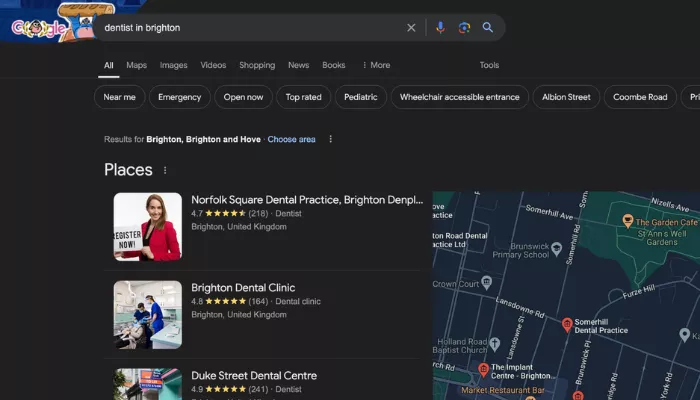
This guide will cover the basics of SEO for dentists and some actionable steps you should consider.
1. Create Direct Landing Pages for Dental Service Keywords
One of the most impactful yet underutilized SEO strategies is creating individual pages for each dental service you offer. Each page should target specific keywords such as “dental fillings” or “laser teeth whitening”.
You can’t expect to rank for these keywords if you don’t create a page for the service and optimize the keyword for it.
Optimizing these pages with local and service-specific keywords helps search engines better understand your offerings and improve the chances of climbing spots in Google’s SERPs.
Arrange the main categories and services underneath them in a precise, logical manner, from main categories such as Orthodontics and General Dentistry to their specific services like Oral Prophylaxis and Porcelain Veneers.
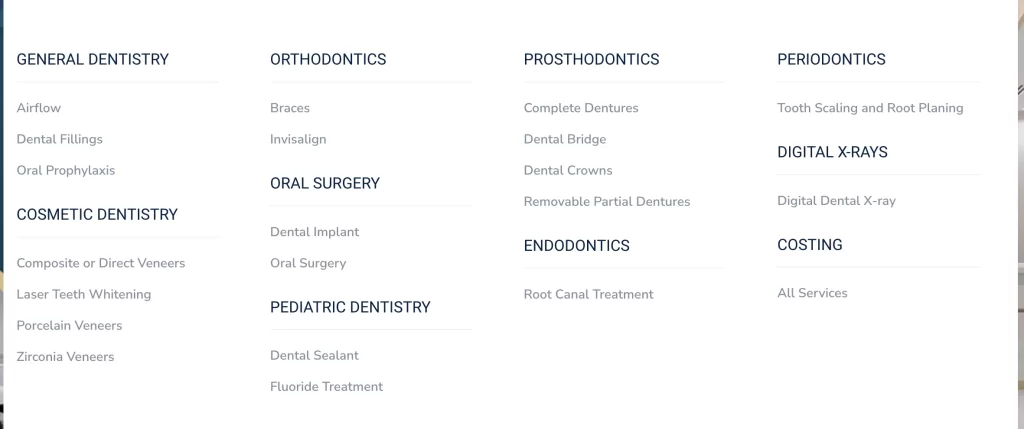
Here’s a quick look at the hierarchy of dental services. You can change it based on your current offerings and local context.
GENERAL DENTISTRY
- Airflow
- Dental Fillings
- Oral Prophylaxis
COSMETIC DENTISTRY
- Composite or Direct Veneers
- Laser Teeth Whitening
- Porcelain Veneers
- Zirconia Veneers
ORTHODONTICS
- Braces
- Invisalign
ORAL SURGERY
- Dental Implant
- Oral Surgery
PEDIATRIC DENTISTRY
- Dental Sealant
- Fluoride Treatment
PROSTHODONTICS
- Complete Dentures
- Dental Bridge
- Dental Crowns
- Removable Partial Dentures
ENDODONTICS
- Root Canal Treatment
PERIODONTICS
- Tooth Scaling and Root Planning
DIGITAL X-RAYS
- Digital Dental X-ray
Publish landing pages with detailed information about the dental service. Include FAQs (Frequently Asked Questions) to address pressing concerns and help potential customers make better decisions about choosing your service (this helps boost the conversion rates for those money pages).
Use internal linking to guide users to related content, assist their navigation experience, and increase their time on your site. Linking related content encourages potential clients to explore your brand further. For instance, if you published the service page on Prosthodontics, link to more specific pages such as Dental Crowns and Dental Bridges.
The better your internal linking strategy, the more page authority it distributes across pages.
2. Apply Author Bio Best Practices
Dentistry falls under the category of "Your Money or Your Life" (YMYL) topics, which refer to subjects that can significantly impact someone’s health, finances, or safety. This means that Google applies stricter guidelines when evaluating content in the field.
Your website must showcase experience, expertise, authoritativeness, and trust (E-E-A-T) to rank well for YMYL topics.
One way to exhibit expertise is to create individual author bios, which can help boost your website's overall brand credibility and SEO performance. Giving users and search engines an idea of the publishers behind every content helps add more positive elements that make your website deserve to rank for its target keywords.
Whether you opt to write blog content as a dentist or hire a medical professional to contribute content for your brand, here are some useful tips to optimize your author bio:
- Include relevant academic degrees, certifications, and professional awards your dentist author has received. Mention the specific institutions and organizations to build more trust with potential patients.
- Use professional headshots similar to those you consistently use across social media platforms, such as the profile photo on LinkedIn. This will create a more recognizable personal brand in the online space.
- Publish a detailed About Us Page. It must include credentials and achievements about your dental practice. Use schema markup to help search engines correctly display your information.
- Link to social media accounts such as Linkedin to help patients verify your qualifications.
3. Optimize Content for Long-Tail Keywords
When starting an SEO campaign, optimizing pages for high-traffic keywords like “dentist near me” is vital as this could bring significant search traffic.
However, if your website is new, it is best to compete for long-tail keywords that are more specific and less competitive. Examples are “Teeth whitening treatment cost in London” or “How often should I get a dental cleaning?”
This enables your newly optimized website to acquire initial traffic by ranking in less time for long-tail keywords.
It is best to incorporate these long-tail keywords naturally throughout your helpful content.
Here are some examples of dental-related long-tail keywords:
- Best family dentist near [city]
- Affordable cosmetic dentistry in [city]
- Emergency dental care for a broken tooth near me
- How to find a good pediatric dentist in [city]
- Teeth whitening treatment cost in [city]
- Dental implants specialist in [city]
- Pain-free root canal treatment near [city]
- Invisalign vs braces cost in [city]
- How often should I get a dental cleaning
- Gum disease treatment options for seniors
- What to do for a knocked-out tooth emergency
- Sedation dentistry for dental anxiety in [city]
- Best dentist for veneers in [city]
- What to expect during a dental implant consultation
- Holistic dental care for sensitive teeth
4. Encourage Patients to Leave Reviews
Patient reviews are critical in building trust with potential patients. As Google considers the quality of reviews a significant local ranking factor for local businesses, having quality reviews can help your site dominate the top ranking spots.
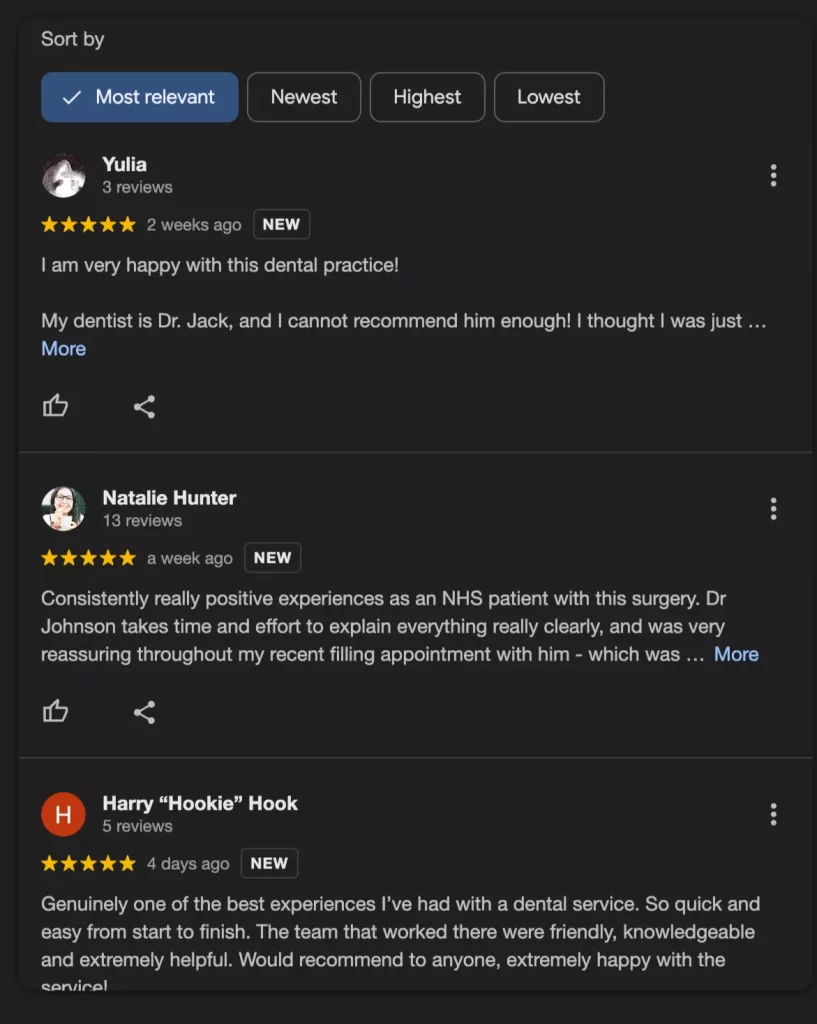
You can display printables in your office with a QR code to encourage patient feedback. Others fashionably use physical marketing materials to help patients share their experiences online.
5. Optimize Google Business Profile
Google Business Profile creation is one of the most fundamental initiatives to help your dental website rank for Google Map Packs.
Fill out all the essential details in the profile to maximize its full potential. A properly optimized profile must include:
- Name, phone number, and address also being placed on your dental site (make sure you consistently place just one NAP - Name, Phone Number, and Address).
- Accurate business hours, contact information, and appointment links
- High-quality images of your clinic, staff, and services
Regularly update your GBP with new promotions, events, and services. All these updates help engage your audience and give Google more content to crawl, which can positively impact your local rankings.
6. Be Visible in Comparative Pages
Getting coverage on publications that rank well in Google’s SERPs for comparative inquiries, like “best orthodontists in London”, could help position your brand strongly online.
We’ve had several names for this type of strategy, as some SEOs have coined it Barnacle SEO, Second-Hand Search Traffic, or Parasite SEO. The goal in any of these is to dominate the top page of SERPs by ranking for comparative pages where you can be appropriately included as a service provider.
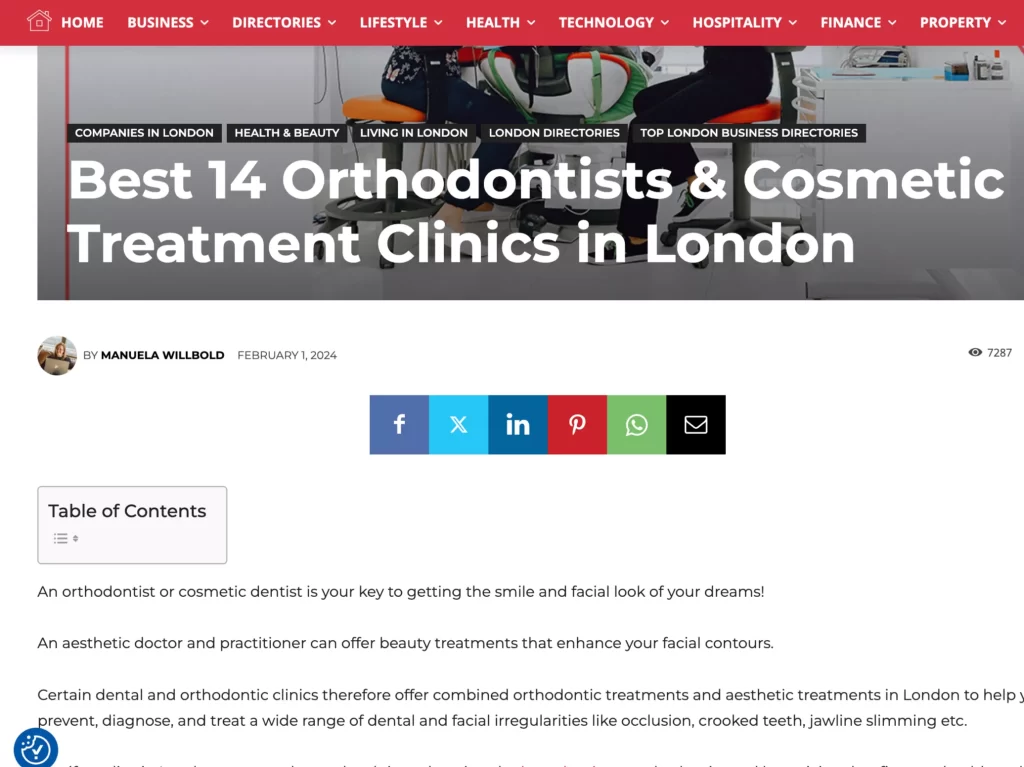
Being visible on these ranking comparative pages can help increase brand share and recall for searchers looking for the best dental clinic in town.
7. Be Included in Local and Healthcare Directories
While getting links from local and niche directories is often misunderstood as merely a link building technique, their value in driving exposure for a dental brand is crucial.
Most users today consider directories a source of options when finding a particular service. They seek niche directories to increase their options, compare service providers, and find the one that will serve their needs.
Start creating and optimizing profiles for healthcare directories like ZocDoc and HealthGrades, as these sites often rank highly on Google’s SERPs.
Drive More Patients to Your Dental Practice
SEO for dentists requires a holistic approach that goes beyond just setting up a Google Business Profile.
By applying the strategies that strongly demonstrate EEAT to help your site foster trust and credibility for search engines and users, you can build a sustainable flow of new patients who trust your practice.
SEO for Family Law: Proven Strategies to Attract More Clients
In the competitive law firm SEO, particularly in family law, getting online visibility is everything. With potential clients turning to Google to find legal services to serve their needs, having a lawyer website that dominates Google’s search engine results pages (SERPs) ensures you’re adding a mix to your marketing strategy.
Working with law firms, I’ve noticed that, more often than not, a typical legal website is just a repository of landing pages that aren’t fully optimized for search, leaving clients with few opportunities to find their legal services.
In this quick guide, we’ll look at the fundamentals of SEO for family law to attract more clients.
1. Structure Menu Items Based on Hierarchy
One way to improve user experience and your site's ability to rank for search is to structure your menu items in a clear, hierarchical manner. This involves arranging the main categories and subcategories in a precise, logical sequence.
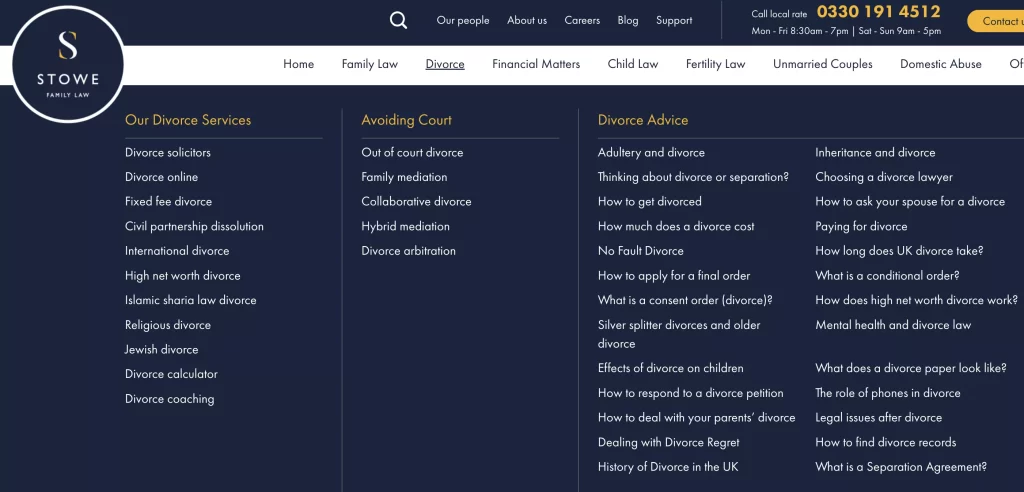
A well-structured menu helps users navigate the website more intuitively and ensures important pages are discovered and indexed correctly. This can improve overall site coverage and rankings for your key pages.
For instance, a parent category labeled “Services” might have categories like “Divorce and Separation”, “Child Custody and Support”, and “Mediation Services”, with more specific landing pages.
Here’s how it looks like in order, for example:
Services
- Divorce and Separation
- Child Custody and Support
- Property Division
- Spousal Support
- Child Custody and Support
- Custody Agreements
- Visitation Rights
- Child Support Modifications
- Mediation Services
- Divorce Mediation
- Family Dispute Mediation
- Child Custody Mediation
- Prenuptial and Postnuptial Agreements
- Adoption Services
- Domestic Violence
- Restraining Orders
- Emergency Protective Orders
2. Rank For Local Organic Listings and Google Map Packs
Local SEO is a critical component for family law firms, as a typical scenario for most clients seeking lawyers near their homes.
Having your legal website at the top of local organic listings and Google Maps packs helps drive new inquiries for your law firm.
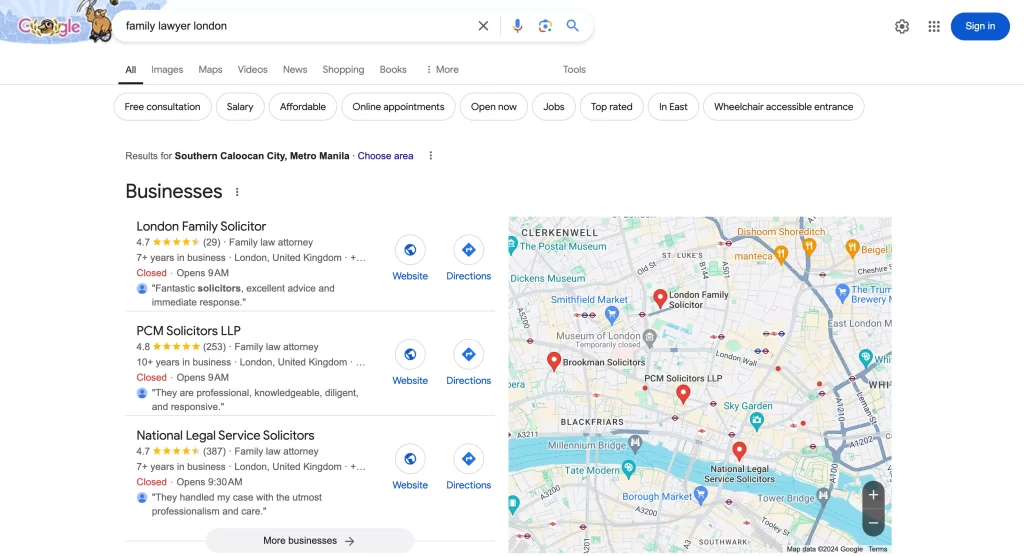
Here are a few action items to optimize your family law site for local search:
- Claim and optimize your Google My Business (GMB) profile.
- Ensure that the firm’s name, address, and phone number (known as NAP in local SEO) are accurate and consistent on your site and other off-page sites, such as citations and local directories.
- Incorporate location-specific keywords in your site’s content, such as “family lawyer in London” or divorce attorney in Brighton”.
- Produce helpful content that resonates well with the local community. Topics may include local laws affecting family matters and comprehensive guides on navigating divorce in your city or region.
- Be listed in citations and legal directories. Your firm should be listed in reputable legal platforms like The Law Society's Solicitor Directory and The Legal 500.
- Ask for reviews from clients. Reviews can help improve your GMB’s rankings for Google Map Packs.
3. Distribute External Content Assets
Contributing content assets to other relevant publications and blogs (guest posts) can help improve your site’s EEAT (Experience, Expertise, Authoritativeness, and Trustworthiness), as these qualities are showcased in the content's caliber.
Through expertly crafted content pieces, you can demonstrate expertise and experience signals that won’t just attract referral traffic and direct visits but potentially assist conversions on backlinks from publications you’re contributing to.
One good example is this law firm in London that distributes content across relevant verticals, i.e., parenting, mommy, and family blogs. All of these have audiences where they can acquire potential clients.
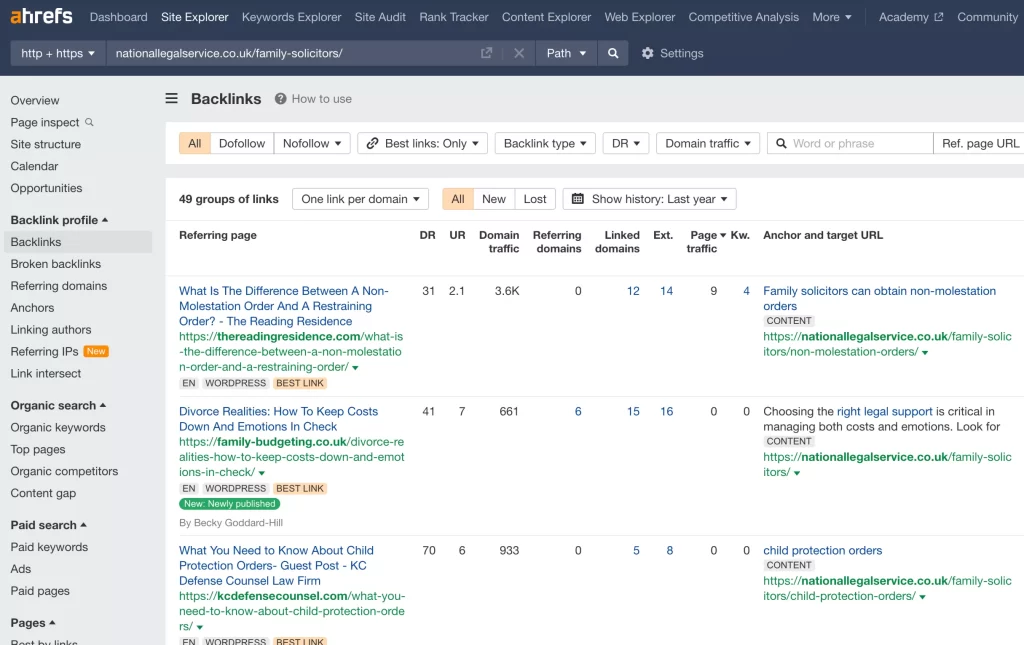
Here’s my list of recommended topics where you can generate even more specific guest blogging ideas:
- Co-Parenting Strategies - Tips and advice on effective co-parenting after divorce, including communication strategies and conflict resolution. (parenting)
- Child Custody and Visitation Rights - legal aspects of child custody, visitation rights, and how to navigate the court system. (parenting)
- Divorce and Family Dynamics - the impact of divorce on family dynamics and how to maintain a healthy environment for children. (parenting and family)
- Financial Planning for Divorced Parents - how to manage finances post-divorce, including child support, alimony, and budgeting tips. (finance and family)
- Legal Rights of Parents: Information on the legal rights of parents in various situations, such as custody disputes, relocation, and schooling decisions. (parenting)
- Domestic Violence Awareness and Resources: Articles focused on recognizing, addressing, and escaping domestic violence, along with legal resources available for victims. (family)
- Prenuptial and Postnuptial Agreements: Educating readers on the importance of these agreements and how they can protect both parties in a marriage. (wedding, family)
- Adoption Process and Legal Considerations - legal process of adoption, including the rights of biological and adoptive parents. (family)
- Mediation vs. Litigation in Family Disputes: The benefits of mediation over litigation in resolving family disputes, including cost, time, and emotional impact. (family)
- Supporting Children Through Divorce: Psychological and legal support for helping children cope with the changes that come with divorce. (family)
- Estate Planning for Families: How to protect your family's future through proper estate planning, including wills, trusts, and guardianship considerations. (real estate, family)
- Parental Rights in Same-Sex Marriages: Legal considerations and challenges. Unique to same-sex couples in matters of adoption, custody, and parental rights. (family, parenting, wedding)
The key to producing any of the mentioned topics is to align it with your contributor’s expertise and experience, as both these attributes will directly impact the quality of the content.
4. Ask For Links From Clients or Networks’ Sites
The legal industry heavily relies on networks to acquire clients. While this could directly affect how the law firm grows as a business, this network, in the form of clients and friends, is also a good source for link building.
You can ask for links from clients or people you’ve known who have their own websites. It may not be as relevant as it is. Still, from the local level, if the website happens to be hosted within a geographic area, it will have a solid value to your law firm, as local backlinks tend to bring more link equity as opposed to getting national links as its counterpart.
SEO For Roofers: How to Rank Higher and Get More Clients
The marketing success of a roofing business no longer hinges solely on word-of-mouth referrals. While those remain vital in the process, you’ll have to continuously consider investing in other channels, such as search engine optimization, to attract new customers for your roofing business.
Imagine a homeowner urgently needs roof repair. A quick search for “roofer New Jersey” finds a list of local roofing companies. Now, if your business doesn’t appear in local map packs and organic listings, you’re missing out on potential clients who are ready to hire.
In this quick guide, I’ll show you how to do SEO for roofers to climb Google’s SERPs for your local keywords and get the desired number of leads for your local business.
1. Achieve NAP Consistency
NAP stands for your business name, address, and phone number. These are the most important elements of a local SEO campaign. With a business name and address, Google can identify your brand and associate it directly with its geographic location. The phone number helps validate that your business is actually located in the place where you mention it through its area code.
Display NAP sitewide in every page’s header or footer and include them on your About Us Page.

If you have several roofing branches, the best approach is to create a location or branches page and state each location’s NAP. Use a local phone number with country and area code so Google can easily identify your location’s business as legitimate.
2. Claim Your Google Business Profile
Google Business is where businesses and other organizations create listings to help enhance their visibility on the search platform.
Creating your own Google Business Profile enables you to add your business details visibly and allows your business to appear on Google Maps Pack.
Fill in all the requested details as you create your Google Business Profile. Make sure you use the same NAP in detail. Don’t forget to complete every detail about your business, including selecting the proper business category and subcategory and your office’s opening hours.
It is best to upload original photos of your roofing service and physical facility. This helps send more positive signals to Google and lets your customers quickly find your business.
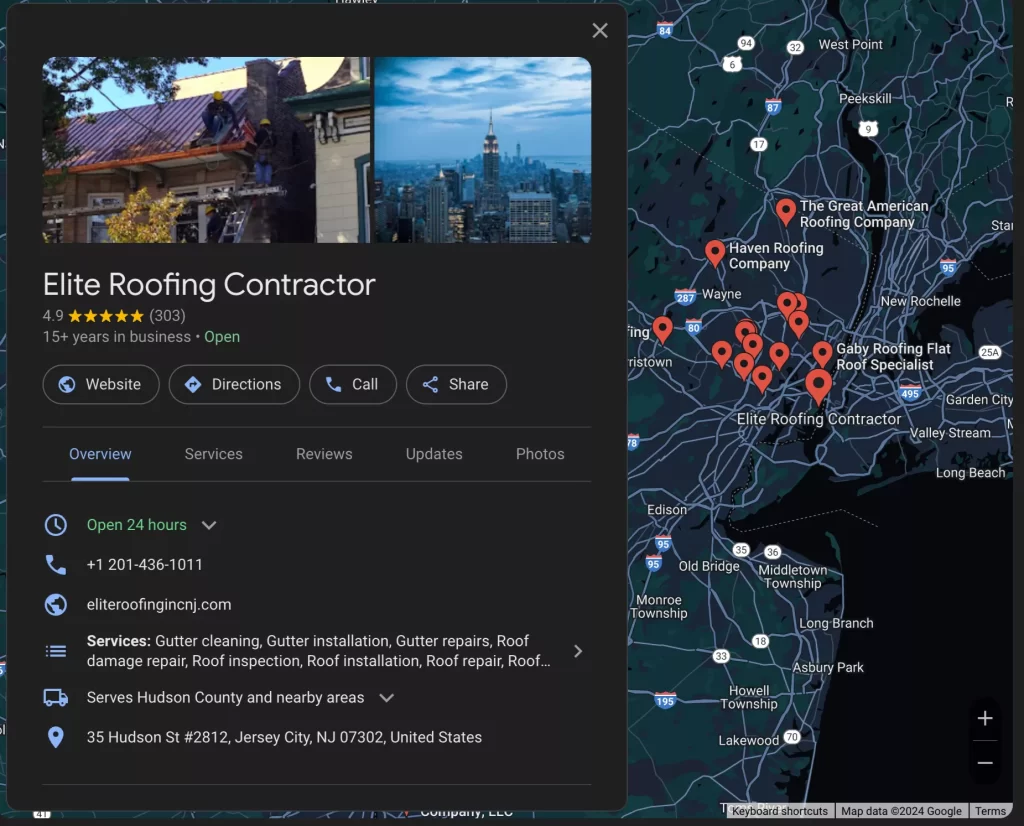
Get genuine reviews to increase the chances of climbing your website for map pack rankings. You can offer some incentives after every roofing service and simply hand them a Google Review QR code to get real honest feedback so they can help you improve your service.
3. Get Listed on Comparative Roofers’ Listings
People use different search queries to find roofing services, such as “best roofing services in New York”. During this purchasing decision stage, they compare different local services, determine both pros and cons through reviews and testimonials, and decide on the best roofing company that could provide the most value for their needs.
Aim to be listed in these listicles hosted on publications that rank well for the comparative terms. This link building method will position your brand visibility in these different places and help you capture an organic search share ready to purchase your services.

Dominating Google’s SERPs for these various investigative keywords by being visible on top-ranking pages helps you position your brand as a go-to source for roofing services.
You can use tools like Ahrefs to find pages or opportunities that feature your top roofing competitors in your local area but don’t include your site.
Reach out for link inclusion. Incentivize by offering free roofing service.
Another way to utilize this product-led link building strategy is to submit content with a list of niche segment services to a publication of choice (e.g., gutter installation services in New Jersey). This is a new angle of content asset they’re likely to publish and promote as it involves a new service category.
4. Build Local Links
Backlinks from sites that target geographic locations can strongly influence your site’s rankings on local organic search results (and could positively affect Google Local Map Packs).
The more quality links you can acquire from sites in your target location, the more local relevance your site will have. These sites do not have to be hosted in the preferred area, but you should aim to build backlinks from sites representing other businesses associated with the place.
Diversify your link types when pursuing backlinks for local SEO for your roofing business. A few kinds you should aim to build:
- Local directories
- Local chambers of commerce
- Local bloggers
- Local publications and news sites
- Local schools and universities
Ahrefs has a “Best by Links” feature that allows you to quickly spot the best link opportunities on websites you’re trying to reverse engineer.
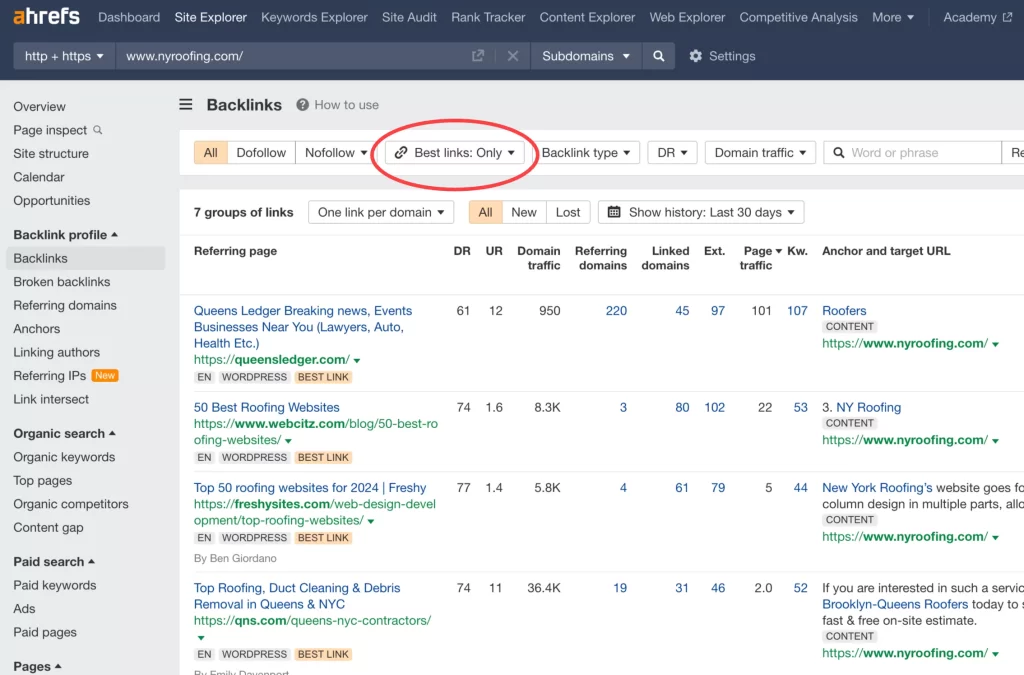
Based on our decade of link building experience as a link building agency, getting links from national and even international websites also helps elevate your pages’ rankings for local organic search listings. However, local links could bring immediate rankings that are better than their link counterparts.
5. Publish Localized Content
One of the best ways to build local links isn’t just through manual SEO outreach but also through consistent publishing of content assets that target your customers’ pain points and challenges. This type of content passively attracts natural links that could help improve the rankings of both your informational content and service pages.
Start by identifying potential topics to cover in Ahrefs’ Question feature. Answer these questions with blog posts.
Optimize content by including keywords in the meta title, meta description, and first sentence. Sprinkle relevant local entities on the page to increase local relevance.
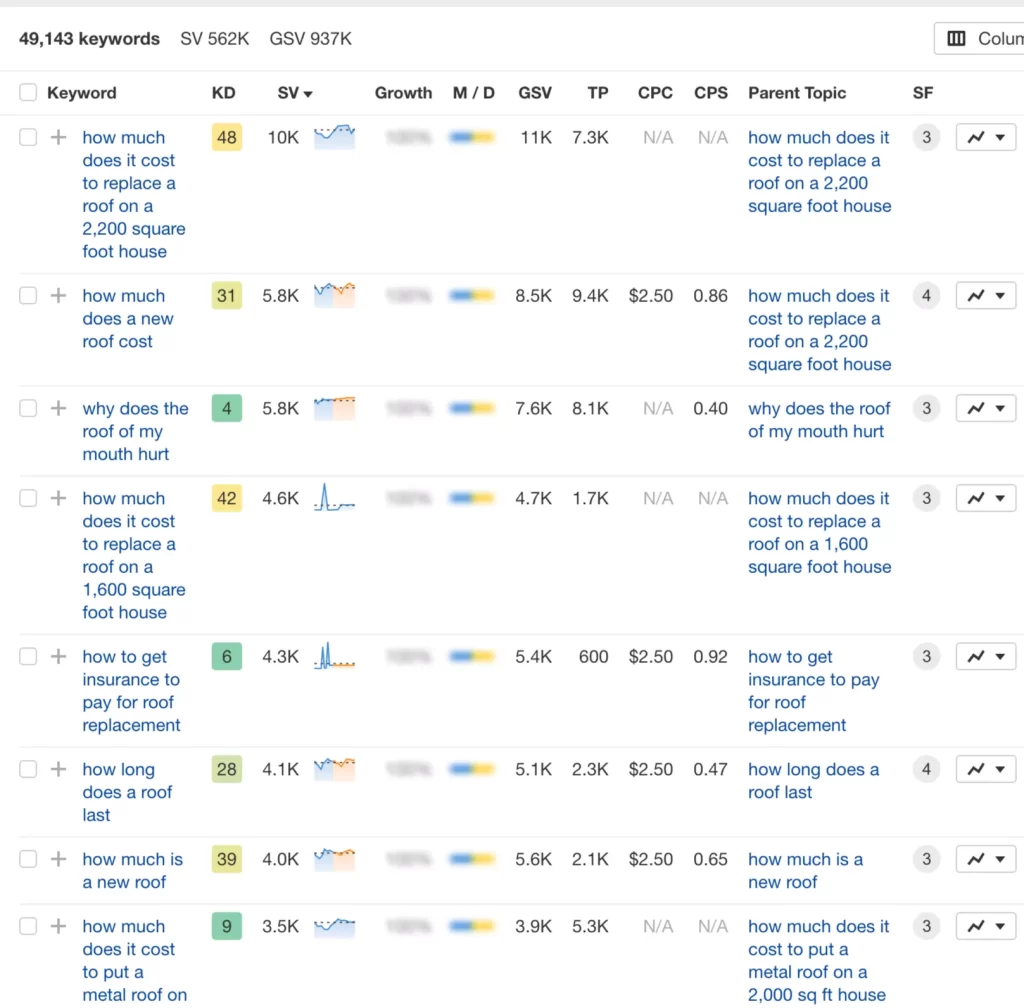
Final Thoughts
Ranking on both Google Map Pack and local organic search listings should be a top priority for any roofing business, as it drives quality leads that they can’t easily find elsewhere.
Being visible on the Map Packs, for instance, is quite underrated but considered to be one of the top search engine optimization techniques for guaranteeing new customers in your neighborhood and boosting your online visibility.
